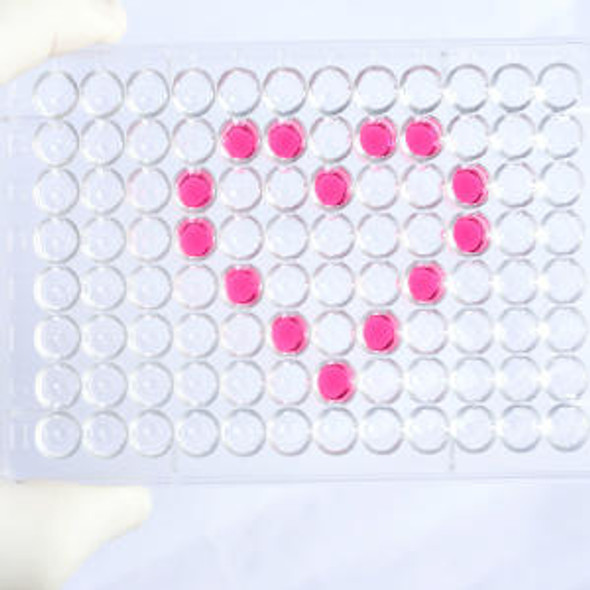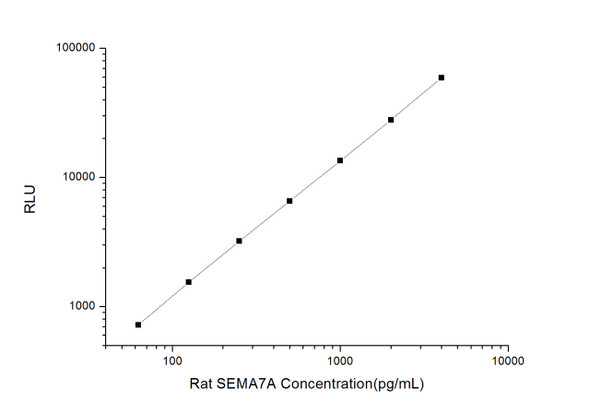Human Developmental Biology ELISA Kits
Human SEMA7A (Semaphorin 7A) CLIA Kit (HUES00632)
- SKU:
- HUES00632
- Product Type:
- ELISA Kit
- ELISA Type:
- CLIA Kit
- Size:
- 96 Assays
- Sensitivity:
- 18.75pg/mL
- Range:
- 31.25-2000pg/mL
- ELISA Type:
- Sandwich
- Synonyms:
- SEMA7-A, CD108, CDw108, H-SEMA-K1, H-Sema-L, JMH, SEMAK1, SEMAL
- Reactivity:
- Human
- Sample Type:
- Serum, plasma and other biological fluids
- Research Area:
- Developmental Biology
Description
| Assay type: | Sandwich |
| Format: | 96T |
| Assay time: | 4.5h |
| Reactivity: | Human |
| Detection method: | Chemiluminescence |
| Detection range: | 31.25-2000 pg/mL |
| Sensitivity: | 18.75 pg/mL |
| Sample volume: | 100µL |
| Sample type: | Serum, plasma and other biological fluids |
| Repeatability: | CV < 15% |
| Specificity: | This kit recognizes Human SEMA7A in samples. No significant cross-reactivity or interference between Human SEMA7A and analogues was observed. |
This kit uses Sandwich-CLIA as the method. The micro CLIA plate provided in this kit has been pre-coated with an antibody specific to Human SEMA7A. Standards or samples are added to the appropriate micro CLIA plate wells and combined with the specific antibody. Then a biotinylated detection antibody specific for Human SEMA7A and Avidin-Horseradish Peroxidase (HRP) conjugate are added to each micro plate well successively and incubated. Free components are washed away. The substrate solution is added to each well. Only those wells that contain Human SEMA7A, biotinylated detection antibody and Avidin-HRP conjugate will appear fluorescence. The Relative light unit (RLU) value is measured spectrophotometrically by the Chemiluminescence immunoassay analyzer. The RLU value is positively associated with the concentration of Human SEMA7A. The concentration of Human SEMA7A in the samples can be calculated by comparing the RLU of the samples to the standard curve.
| UniProt Protein Function: | SEMA7A: Plays an important role in integrin-mediated signaling and functions both in regulating cell migration and immune responses. Promotes formation of focal adhesion complexes, activation of the protein kinase PTK2/FAK1 and subsequent phosphorylation of MAPK1 and MAPK3. Promotes production of proinflammatory cytokines by monocytes and macrophages. Plays an important role in modulating inflammation and T-cell-mediated immune responses. Promotes axon growth in the embryonic olfactory bulb. Promotes attachment, spreading and dendrite outgrowth in melanocytes. Belongs to the semaphorin family. |
| UniProt Protein Details: | Protein type:Membrane protein, GPI anchor Chromosomal Location of Human Ortholog: 15q22. 3-q23 Cellular Component: external side of plasma membrane; extracellular space; membrane; plasma membrane Molecular Function:chemorepellent activity; integrin binding; protein binding; semaphorin receptor binding Biological Process: immune response; integrin-mediated signaling pathway; negative chemotaxis; negative regulation of axon extension involved in axon guidance; neural crest cell migration; osteoblast differentiation; positive regulation of axon extension; positive regulation of cell migration; regulation of inflammatory response Disease: Blood Group, John Milton Hagen System |
| NCBI Summary: | This gene encodes a member of the semaphorin family of proteins. The encoded preproprotein is proteolytically processed to generate the mature glycosylphosphatidylinositol (GPI)-anchored membrane glycoprotein. The encoded protein is found on activated lymphocytes and erythrocytes and may be involved in immunomodulatory and neuronal processes. The encoded protein carries the John Milton Hagen (JMH) blood group antigens. Mutations in this gene may be associated with reduced bone mineral density (BMD). Alternative splicing results in multiple transcript variants, at least one of which encodes an isoform that is proteolytically processed. [provided by RefSeq, Feb 2016] |
| UniProt Code: | O75326 |
| NCBI GenInfo Identifier: | 14548264 |
| NCBI Gene ID: | 8482 |
| NCBI Accession: | O75326. 1 |
| UniProt Secondary Accession: | O75326,Q1XE81, Q1XE82, Q1XE83, Q1XE84, Q3MIY5, B4DDP7 F5H1S0, |
| UniProt Related Accession: | O75326 |
| Molecular Weight: | 73,364 Da |
| NCBI Full Name: | Semaphorin-7A |
| NCBI Synonym Full Names: | semaphorin 7A (John Milton Hagen blood group) |
| NCBI Official Symbol: | SEMA7A |
| NCBI Official Synonym Symbols: | JMH; CD108; SEMAL; CDw108; SEMAK1; H-Sema-L; H-SEMA-K1 |
| NCBI Protein Information: | semaphorin-7A |
| UniProt Protein Name: | Semaphorin-7A |
| UniProt Synonym Protein Names: | CDw108; JMH blood group antigen; John-Milton-Hargen human blood group Ag; Semaphorin-K1; Sema K1; Semaphorin-L; Sema L; CD_antigen: CD108 |
| Protein Family: | Semaphorin |
| UniProt Gene Name: | SEMA7A |
| UniProt Entry Name: | SEM7A_HUMAN |
As the RLU values of the standard curve may vary according to the conditions of the actual assay performance (e. g. operator, pipetting technique, washing technique or temperature effects), the operator should establish a standard curve for each test. Typical standard curve and data is provided below for reference only.
| Concentration (pg/mL) | RLU | Average | Corrected |
| 2000 | 53525 57917 | 55721 | 55693 |
| 1000 | 22930 25018 | 23974 | 23946 |
| 500 | 11738 10326 | 11032 | 11004 |
| 250 | 5154 5434 | 5294 | 5266 |
| 125 | 2738 2478 | 2608 | 2580 |
| 62.5 | 1382 1240 | 1311 | 1283 |
| 31.25 | 639 709 | 674 | 646 |
| 0 | 27 29 | 28 | -- |
Precision
Intra-assay Precision (Precision within an assay): 3 samples with low, mid range and high level Human SEMA7A were tested 20 times on one plate, respectively.
Inter-assay Precision (Precision between assays): 3 samples with low, mid range and high level Human SEMA7A were tested on 3 different plates, 20 replicates in each plate.
| Intra-assay Precision | Inter-assay Precision | |||||
| Sample | 1 | 2 | 3 | 1 | 2 | 3 |
| n | 20 | 20 | 20 | 20 | 20 | 20 |
| Mean (pg/mL) | 99.72 | 188.85 | 770.92 | 98.46 | 176.95 | 794.75 |
| Standard deviation | 8.14 | 20.45 | 52.50 | 11.03 | 14.24 | 78.28 |
| C V (%) | 8.16 | 10.83 | 6.81 | 11.20 | 8.05 | 9.85 |
Recovery
The recovery of Human SEMA7A spiked at three different levels in samples throughout the range of the assay was evaluated in various matrices.
| Sample Type | Range (%) | Average Recovery (%) |
| Serum (n=5) | 96-113 | 103 |
| EDTA plasma (n=5) | 100-114 | 107 |
| Cell culture media (n=5) | 95-108 | 101 |
Linearity
Samples were spiked with high concentrations of Human SEMA7A and diluted with Reference Standard & Sample Diluent to produce samples with values within the range of the assay.
| Serum (n=5) | EDTA plasma (n=5) | Cell culture media (n=5) | ||
| 1:2 | Range (%) | 93-108 | 88-100 | 86-99 |
| Average (%) | 99 | 94 | 92 | |
| 1:4 | Range (%) | 89-100 | 98-109 | 89-100 |
| Average (%) | 95 | 104 | 94 | |
| 1:8 | Range (%) | 103-119 | 102-115 | 100-116 |
| Average (%) | 110 | 108 | 107 | |
| 1:16 | Range (%) | 100-119 | 92-104 | 92-108 |
| Average (%) | 108 | 98 | 98 |
An unopened kit can be stored at 4°C for 1 month. If the kit is not used within 1 month, store the items separately according to the following conditions once the kit is received.
| Item | Specifications | Storage |
| Micro CLIA Plate(Dismountable) | 8 wells ×12 strips | -20°C, 6 months |
| Reference Standard | 2 vials | |
| Concentrated Biotinylated Detection Ab (100×) | 1 vial, 120 µL | |
| Concentrated HRP Conjugate (100×) | 1 vial, 120 µL | -20°C(shading light), 6 months |
| Reference Standard & Sample Diluent | 1 vial, 20 mL | 4°C, 6 months |
| Biotinylated Detection Ab Diluent | 1 vial, 14 mL | |
| HRP Conjugate Diluent | 1 vial, 14 mL | |
| Concentrated Wash Buffer (25×) | 1 vial, 30 mL | |
| Substrate Reagent A | 1 vial, 5 mL | 4°C (shading light) |
| Substrate Reagent B | 1 vial, 5 mL | 4°C (shading light) |
| Plate Sealer | 5 pieces | |
| Product Description | 1 copy | |
| Certificate of Analysis | 1 copy |
- Set standard, test sample and control (zero) wells on the pre-coated plate and record theirpositions. It is recommended to measure each standard and sample in duplicate. Note: addall solutions to the bottom of the plate wells while avoiding contact with the well walls. Ensuresolutions do not foam when adding to the wells.
- Aliquot 100µl of standard solutions into the standard wells.
- Add 100µl of Sample / Standard dilution buffer into the control (zero) well.
- Add 100µl of properly diluted sample (serum, plasma, tissue homogenates and otherbiological fluids. ) into test sample wells.
- Cover the plate with the sealer provided in the kit and incubate for 90 min at 37°C.
- Aspirate the liquid from each well, do not wash. Immediately add 100µL of BiotinylatedDetection Ab working solution to each well. Cover the plate with a plate seal and gently mix. Incubate for 1 hour at 37°C.
- Aspirate or decant the solution from the plate and add 350µL of wash buffer to each welland incubate for 1-2 minutes at room temperature. Aspirate the solution from each well andclap the plate on absorbent filter paper to dry. Repeat this process 3 times. Note: a microplatewasher can be used in this step and other wash steps.
- Add 100µL of HRP Conjugate working solution to each well. Cover with a plate seal andincubate for 30 min at 37°C.
- Aspirate or decant the solution from each well. Repeat the wash process for five times asconducted in step 7.
- Add 100µL of Substrate mixture solution to each well. Cover with a new plate seal andincubate for no more than 5 min at 37°C. Protect the plate from light.
- Determine the RLU value of each well immediately.






